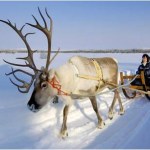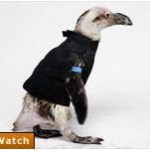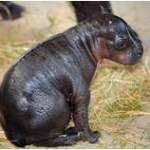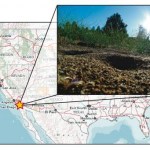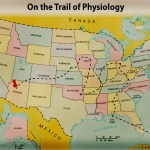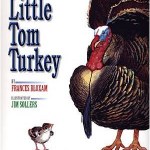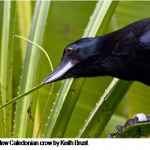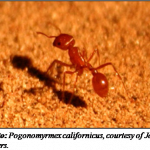
With the holidays literally around the corner, what more appropriate topic to talk about than reindeer!
Many animals maintain a circadian rhythm, which is controlled by a group of cells in an area of the brain called the hypothalamus. This rhythm controls many of the daily and seasonal activities in animals by telling them when to be awake, sleep, forage, migrate, mate, etc. It works great for animals in environments where the day-night cycles occur regularly, but what about arctic reindeer who live in conditions of extended daylight in the summer and darkness in the winter? Researchers Lu…
I loved the movie "March of the Penguins." Now, thanks to the California Academy of Sciences, I can watch penguins live anytime I want on one of their three webcams! I find myself watching the penguins just to relax in the middle of the day. I highly recommend you check out this website and watch the penguins, too...we can watch them together. Although I would not recommend watching them at night, as it can be rather boring.
The website is really neat and also has information on what it is like to be a penguin wrangler. Yes, someone actually gets paid to wrangle penguins. There is also a…
OK, Pygmy Hippos are really cute. Well, baby pygmy hippos are really cute. And that's kind of strange considering it looks like the morph of a pig and a hippo. I mean, piglets are cute, but grown pigs are certainly not the easiest thing on the eyes. And hippos, well, they're just odd looking. But the pygmy hippo got the best of both worlds, and they are really interesting creatures when you take a look at their adaptations.
Just take a look at the photo above of a pygmy hippo that was born just last month at Zoo Miami. She doesn't have a name yet, but zookeepers are doing an online poll to…
You know that age-old argument dog people and cat people can't ever seem to agree on? The one about whether dogs or cats are smarter? Well, we may finally have an answer! (Spoiler alert: I'm pretty stoked, as a dog person.) According to a new study by Oxford University, researchers have discovered extreme differences in how the brains of different mammals have evolved over time. The study notes there is a link between the level of social interaction of mammals and the size of their brain relative to their body size.
Lead author Dr. Susanne Shultz said, "Cooperation and coordination for…
I recently wrote about how incredibly athletic sled dogs are, and given the recent weather forecasts for snow around the nation, I decided why not continue? Today, I'll focus on how similar the physiology of sled dogs is to human physiology (answer: extremely similar), and how this could possibly help two very different kinds of people - athletes and diabetics.
In this video, Dr. Michael Davis of the American College of Veterinary Internal Medicine is interviewed by Steve Dale about the capacity of a sled dog's physiology to adapt to extreme stress. He says sled dogs are the greatest…
Mice get all the interesting experiments! A new study released on Nov. 28 explained how Harvard researchers reversed the aging process in genetically altered mice. Now, I don't know about you, but the first question I asked was, "What kind of physiological changes need to happen for that to even be a possibility?" While mice are known to be good indications of how humans may react to treatments for disease, or alterations to our body's physiological system, it still makes me hesitate a little bit. However, mice have, in the words of the study's lead author Dr. Ronald DePinho, "illuminated a…
In a recent post, Dr. Dolittle reviewed some of our recent findings about the metabolic rate of ant colonies. We focused on the harvester ant, Pogonomyrmex californicus, a species with wide geographic distribution across the southwestern United States:
If you are interested, there is a large collection of Pogonomyrmex resources available online thanks to Bob Johnson and the Social Insect Research Group at Arizona State University. From this website, you can find out about how to identify seed harvester ants, find detailed range maps, and also learn how to culture colonies in the lab.…
Image: Copyright BrotherSoft
Ever wonder how the patterns of stripes and spots develop in animals? Researchers Michael Cohen, Buzz Baum and Mark Miodownik were wondering the same thing and have published their findings in the Journal of the Royal Society Interface. They were able to construct a mathematical model to show how developing cells communicate with each other through actin-based filopodia, which are little projections from the cells. These filopodia communicate with other cells through chemical signals that can inhibit or stimulate to indicate which color each cell should be. As…
While searching the website of The American Physiological Society, I discovered that there are local chapters of the society all across America. So I have decided to bring highlights from their meetings to you. We will be starting with the Arizona Physiological Society as they just held their annual meeting at Midwestern University in Glendale, Arizona.
Here are some highlights of current non-comparative physiology research from the meeting's abstracts:
Arsenic in Airways: Researchers at The University of Arizona (Tucson, AZ) have been studying the effects of arsenic on the epithelial cells…
While searching the website of The American Physiological Society, I discovered that there are local chapters of the society all across America. So I have decided to bring highlights from their meetings to you. We will be starting with the Arizona Physiological Society as they just held their annual meeting at Midwestern University in Glendale, Arizona.
Here are some highlights of current comparative physiology research from the meeting's abstracts for Saturday November 6th:
Squid Accessory Hearts: Researchers at Northern Arizona University (Flagstaff, AZ) are studying squid, which have…
While searching website of The American Physiological Society, I discovered that there are local chapters of the society all across America. So I have decided to bring highlights from their meetings to you. We will be starting with the Arizona Physiological Society as they just held their annual meeting at Midwestern University in Glendale, Arizona.
Here are some highlights of current comparative physiology research from the meeting's abstracts for Friday November 5th:
Bullfrog Bones: Researchers at Northern Arizona University (Flagstaff, AZ) are in the process of building a computerized…
Most people probably only think of turkeys as the delicious main course served with gravy, mashed potatoes, and cranberry sauce (among many other items) at Thanksgiving. I too have mainly been concerned with how best to prepare them for dinner and have admittedly not given much thought to their anatomy or physiology. So, with Thanksgiving literally right around the corner, let's discuss turkeys.
In many species, young birds do not display external sexual characteristics, like differences in feather color. However, knowing the gender of a young bird is very important to poultry breeders to…
When I saw the advertisement for the NOVA special on dogs called Dogs Decoded, I just had to watch it! This special shows just how smart man's best friend really is. If you have ever owned a dog, you have probably noticed that they seem to be tuned in to how we feel. In this special, scientists sought to figure out just how tuned in they really are. What they found was that dogs are actually able to read human emotions in a way that is similar to how humans assess each other's emotions. Moreover, humans were able to interpret the meaning of various barks that dogs make. Can you decode the…
I just watched the most amazing special called "A Murder of Crows". Crows are the most intelligent birds. They demonstrate an amazing ability to learn either from their parents, from watching other birds, or from trial and error. One of the attributes that I found most amazing was their ability to recognize human faces and to teach their naïve young to avoid specific human faces they found threatening. Studies like these show that crows have a sophisticated ability to communicate. In fact, researchers were said to have identified over 250 distinct calls, with individuals also having 2…
The research of James Waters and Jon Harrison from Arizona State University on ant metabolism was recently featured in a press release from The American Physiological Society.
Mr. Waters and Dr. Harrison have measured the standard metabolic rates of individual ants as well as whole ant colonies. What they found was that the colony produced only 75% of the by-products that would be produced by individual ants if each lived in isolation. In other words, the metabolism of the colony was less than the sum of each individual ant's metabolism. Moreover, they found that larger colonies had lower…
Caitlin O'Connell-Rodwell is Co-founder/CEO of Utopia Scientific and an instructor in the Department of Otolaryngology at Stanford University in California. Research in the O'Connell-Rodwell laboratory focuses on communication through vibrations in large mammals.
In a previous blog, I discussed Dr. O'Connell-Rodwell's research as presented in a feature podcast from The American Physiological Society. Her research on elephant communication sparked quite a bit of conversation. Therefore, I decided to invite Dr. O'Connell-Rodwell to be interviewed, and she agreed. Here is the final exerpt from…
Caitlin O'Connell-Rodwell is Co-founder/CEO of Utopia Scientific and an instructor in the Department of Otolaryngology at Stanford University in California. Research in the O'Connell-Rodwell laboratory focuses on communication through vibrations in large mammals.
In a previous blog, I discussed Dr. O'Connell-Rodwell's research as presented in a feature podcast from The American Physiological Society. Her research on elephant communication sparked quite a bit of conversation. Therefore, I decided to invite Dr. O'Connell-Rodwell to be interviewed, and she agreed. Here is an excerpt from our…
Caitlin O'Connell-Rodwell is Co-founder/CEO of Utopia Scientific and an instructor in the Department of Otolaryngology at Stanford University in California. Research in the O'Connell-Rodwell laboratory focuses on communication through vibrations in large mammals.
In a previous blog, I discussed Dr. O'Connell-Rodwell's research as presented in a feature podcast from The American Physiological Society. Her research on elephant communication sparked quite a bit of conversation. Therefore, I decided to invite Dr. O'Connell-Rodwell to be interviewed, and she agreed. Here is an exerpt from our…
For those of you who read the previous blog, you get the idea behind today's offering. Namely, that October is celebration/awareness month of a host of health-related causes, among them: children's health, dyslexia awareness, healthy lung, lupus awareness, national breast cancer awareness, and national spina bifida.
This struck me as a good time to step back and reflect on how, only 50 or so years ago, a group of pioneers were able to bring us what is known today as noninvasive heart care. The story is detailed in an article entitled, "Standing on the Shoulders of Giants: Dean Franklin and…
Fifty-two years ago the average American home cost $30,000, Elvis Presley wooed listeners with Hard Headed Woman, and the hula-hoop was introduced. That same year, 1958, a team comprised of a groundbreaking engineer -- Dean Franklin -- in concert with two exceptional physicians -- Drs. Robert Rushmer and Robert Van Citters - was laying the foundation for what would eventually become a radical new approach to health care: the noninvasive imaging and treatment of the heart. The discoveries of these pioneers would eventually lead to a doctor's ability to see the heart without cutting open the…
